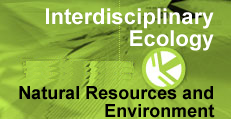On May the 28th, 2004, I successfully defended my Dissertation
and, soon after that, it was accepted as electronic publication
by the Editorial Office of the Graduate School of the University
of Florida. The dissertation document and the actual decision
support system are publicly available through the UF library:
Modeling
north florida dairy farm management strategies to alleviate ecological
impacts under varying climatic conditions: an interdisciplinary
approach (cabrera_v.pdf) and
the Dynamic North Florida Dairy Farm Model (DyNoFlo).
My Dissertation research started in middle 2002 and it was about
ways of decreasing environmental impacts of north Florida dairy
farm operations (especially nitrogen pollution to groundwater)
while maintaining farm profitability in an interdisciplinary approach.
I used innovative simulation methodologies to represent these
dairy farms and test best management practices (BMP) that result
in better outputs.
I had a very rich Dissertation process, including a series of
activities as: a sondeo, focus groups, profound interactions with
stakeholders, research of similar issues, some GIS databases and
interpolation works, and the development of a prototype model.
Many other interesting things also happened as the formal farmers’
interviews, the participatory model validation, the analyses and
take home messages, and the preparation of professional articles
for publication.
As an exercise of students from Farming Systems Research and
Extension course about interview methodologies, a rapid rural
appraisal interview or sondeo was realized with stakeholders in
the issue nutrient management and nitrogen pollution in the Suwannee
River Basin. A Report
was the final product that is now part of the South Eastern Consortium
Paper Series.
Inherent conditions of my research are the participatory approaches
and because of that many
interactions were achieved.
Nutrient pollution from dairy farms in north Florida and the
realized actions to its alleviation are contrasting from those
in south Florida. While in north Florida the main issue is groundwater
nitrogen pollution, in south Florida the problem is phosphorus
run-off. A quick
assessment of the phosphorus issue in south Florida was also
done in order to compare it with the north Florida situation.
Part of the study requires calibration of complementary models
(mostly crop models), which will estimate the nitrogen uptake
and the dry matter accumulation by manure applied crops. Some
studies were carried out as a way to better understand these processes
in the area of study as this Simulation
of Nitrogen Leaching and Pasture Production in a Diary Farm
that includes a series of simulations at the farm level. Another
project was Temporal
and Spatial Nitrogen Modeling in a Suwannee Farm using GIS.
For suggestion of one stakeholder a prototype model was set up
with its correspondent
documentation. This model is an user-friendly, stochastic,
empirical model constructed on an Excel spreadsheet using Visual
Basic embedded software. The model, called Dynamic North Florida
Dairy Farm Model (DNFDFM), estimates monthly rates of nitrogen
lost and profitability for a dairy farm using parameters input
by user. This model was not a final version, but is a useful tool
for analyses and interaction with farmers. You can download the
DNFDFM model and
run it.




